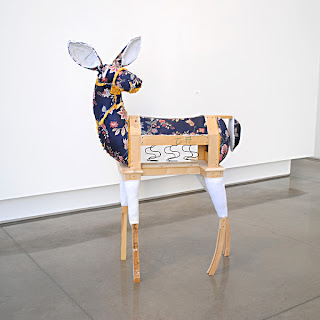In a year that felt abundant with looks back at great artists my biggest regret in terms of seeing art is not having made it to New York for MoMA’s first ever retrospective of Willem de Kooning. Of course no one can be everywhere, and while I was fortunate enough to be in a lot of places this year, the trouble with being all over is that you’re bound to miss a lot from any one place in particular. So again I offer a selection of the best new works and exhibitions I managed to see over the past year. My route was at times directed by art, and at others by the whims of my life, but having bounced up and down both coasts and through several cities in between, I hope the list presented here can provide some kind of useful sample of the best the country had to offer in 2011.
A Small Self-Portrait
The year got off to a strong start with three exceptional pieces on display simultaneously at UCLA’s Armand Hammer Museum. Roberto Cuoghi's untitled self-portrait is a rare achievement in the practice of drawing. Far from feeling academic, this small piece is a staggering turn of realism with a figure as viscerally present as any painted by Manet or even Rembrandt. Coughi's portrait is unpretentious and uncanny, and reinforces realism's place in contemporary discourse — though given the rest of the portraits in this body of work, Cuoghi certainly doesn't subscribe to the school of though that prizes it above all else.
The Cutters

In adjacent galleries could be found the Hammer's All Of This And Nothing, featuring, among other works, Gedi Sibony’s The Cutters. The language of this piece was so concise, and its feeling of completion so thorough, it was clear from the beginning this would likely be one of the best things I’d see. Sibony is truly one to traffic in arrangements. As reported in W magazine a few years back, “He avoids altering his finds from their original state [...]. Before an opening he’ll spend days arranging his works so that the light will energize them, creating rich ‘situations’ for viewers.” The richness of The Cutters was, as mentioned, a quiet and powerful thing to behold.
Anticultural Positions
Also part of All Of This And Nothing was Paul Sietsema’s Anticultural Positions, a thirty-minute, looped film featuring black and white stills of the artist’s working surfaces interspersed with text from a lecture he reportedly presented in 2008. The effect was disjointed and abstract, a gorgeous visual experience complimented by the mesmerizing rattle of the projector. Literally readable in parts, but overall quite bewildering, Anticultural Positions nevertheless created an atmosphere to be savored.
The End
In Pittsburgh, another video piece proved even more enthralling. Ragnar Kjartansson’s The End, on view at the Carnegie Museum, enveloped its audience in a visual and and auditory landscape like nothing I’ve ever encountered. The weird, warped music and vast, white wilderness combined to create an environment both serene and exhilarating, and Kjartansson’s odd mix of exuberance and flippancy make him a joy to watch.
Picasso: Masterpieces from the Musée National Picasso, Paris

Another collection of greatly varied styles came from an in-depth look at a single artist in the de Young Museum’s Picasso. It was the same traveling show that left Seattle earlier in the year, drawn from the currently renovating Musée National Picasso in Paris. Now, I’ve visited that museum, but something about the way this show was laid out made the work absolutely thrilling. While it felt a little thin in the early years — a number of Picasso’s best early works having been snagged by the Steins, interestingly — man, did Picasso take off as he got older. Still lifes, portraits, busts, bathers, and even some lesser known landscapes from the artist’s early days to his last made Picasso an unforgettable look at the master.
B. Wurtz: Works, 1970 - 2011

And maybe equally unforgettable was Metro Pictures Gallery’s retrospective of B. Wurtz. Little known outside the confines of artistic circles, Wurtz has been steadily producing smart, playful sculptures since the 1970s. Some of these are freestanding, some hang on the wall, but all incorporate surprisingly common objects to produce compositions of uncommon originality and wit. So light are Wurtz’s creations that they made even Richard Tuttle’s work, concurrent at the nearby Pace Gallery, feel leaden. Reviewing the show in June, Roberta Smith was quite right in her sentiment that, “Mr. Wurtz’s show may be, in its own quiet and eccentric way, one of the high points of the summer, if not the entire year.”











